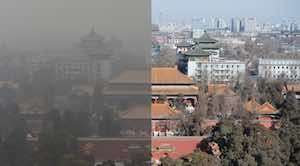
A new study suggests air pollution is even worse than thought in China where pollution is sky-high everywhere. Some 83% of Chinese are exposed to air that, in America, would be deemed by the EPA either to be unhealthy or unhealthy for sensitive groups. Almost half of the population of China experiences levels of PM2.5 that are above America's highest threshold. Berkeley's Earth scientific director, Richard Muller, says breathing Beijing air is the equivalent of smoking almost 40 cigarettes a day. (1)
China emits more CO2 than the US and Canada put together—up 171% since the year 2000. (2)
Then there is the reminder of just how unreliable Chinese government data can be. China consumed as much as 14% more coal on an energy-content basis than previously reported. Its domestic coal production meanwhile was as much as 7% higher between 2000 and 2013. (3)
Last year China installed more new wind and solar capacity than any country in history. This is a fact, and it has led some to talk of China being a 'renewable powerhouse' and of there being a 'renewables revolution.' (4)
But out of context, using recent data, this fact can be much less impressive than it really is. Over the last decade China's primary energy consumption grew by 1398 million tons of equivalent (Mtoe). The average annual increase was 140 Mtoe. For a comparison, Britain's annual primary energy consumption was 188 Mtoe last year.
How does China's world leading wind and solar build out compete with this? In total, China got 42.4 Mtoe from wind and solar in 2014. In other words, the total production of energy from wind and solar energy is less than one-third of a year's growth in primary energy consumption. When you look at annual growth things are even clearer. Wind and solar grew by 6.97 Mtoe last year. This is a mere 5% of the average total growth in primary energy. (4)
There is no renewables revolution in China.
Despite additions of substantial wind, solar, and nuclear capacity, when properly adjusted for capacity factor (the amount of annual energy produced per unit of capacity) to reflect production capability, the amount of new coal energy added to the China grid last year exceeded new solar energy by 17 times, new wind energy by more than 4 times, and even new hydro by more than 3 times. And, despite have more than 30 new nuclear reactors under construction, China's new nuclear capability was still a fraction of new coal energy. (5)
Add to this the thousands of ships that ply China's waterways delivering a toxic cocktail of pollution. Seven of the world's 10 largest ports are in China, with more than a quarter of the planet's maritime cargo passing through China and its heavily populated coastal cities. With ocean going ships allowed to burn fuel with sulfur levels that are 100 to 3,500 times higher than permitted in on-road diesel, one container ship cruising along the coast of China emits as much diesel pollution as 500,000 new Chinese trucks in a single day. (6)
Lastly, there's the issue of China making the world's products. In this area in terms of carbon they are horribly inefficient compared to the west. When Chinese make steel, they make 2.8 times as much 'pollution,' When they make cast iron it is 4.1 times as 'polluting.' When they make polypropylene, they generate 18.4 times as much CO2. (7)
References
- “Mapping the invisible scourge,” The Economist, August 15, 2015
- Simon Rogers and Lisa Evans, “World carbon dioxide emissions data by country: China speeds ahead of the rest,” The Guardian, January 31, 2011
- Brain Spegele, “China's coal consumption 14% higher than previously thought,” The Wall Street Journal, September 17, 2015
- “Carbon counter,” carboncounter.wordpress.com, June 17, 2015
- Andrew C. Revkin, “A look behind the headlines on China's coal trends,” The New York Times, February 18, 2015
- Stian Reklev and Michael Perry, “China shipping delivers toxic pollution cocktail-report,” reuters.com, December 29, 2014
- Zhu Liu et al., “Targeted opportunities to address the climate-trade dilemma in China,” Nature Climate Change, 2015, DOI: 10.1038/nclimate2800
 A new study suggests air pollution is even worse than thought in China where pollution is sky-high everywhere. Some 83% of Chinese are exposed to air that, in America, would be deemed by the EPA either to be unhealthy or unhealthy for sensitive groups. Almost half of the population of China experiences levels of PM2.5 that are above America's highest threshold. Berkeley's Earth scientific director, Richard Muller, says breathing Beijing air is the equivalent of smoking almost 40 cigarettes a day. (1)
China emits more CO2 than the US and Canada put together—up 171% since the year 2000. (2)
Then there is the reminder of just how unreliable Chinese government data can be. China consumed as much as 14% more coal on an energy-content basis than previously reported. Its domestic coal production meanwhile was as much as 7% higher between 2000 and 2013. (3)
A new study suggests air pollution is even worse than thought in China where pollution is sky-high everywhere. Some 83% of Chinese are exposed to air that, in America, would be deemed by the EPA either to be unhealthy or unhealthy for sensitive groups. Almost half of the population of China experiences levels of PM2.5 that are above America's highest threshold. Berkeley's Earth scientific director, Richard Muller, says breathing Beijing air is the equivalent of smoking almost 40 cigarettes a day. (1)
China emits more CO2 than the US and Canada put together—up 171% since the year 2000. (2)
Then there is the reminder of just how unreliable Chinese government data can be. China consumed as much as 14% more coal on an energy-content basis than previously reported. Its domestic coal production meanwhile was as much as 7% higher between 2000 and 2013. (3)